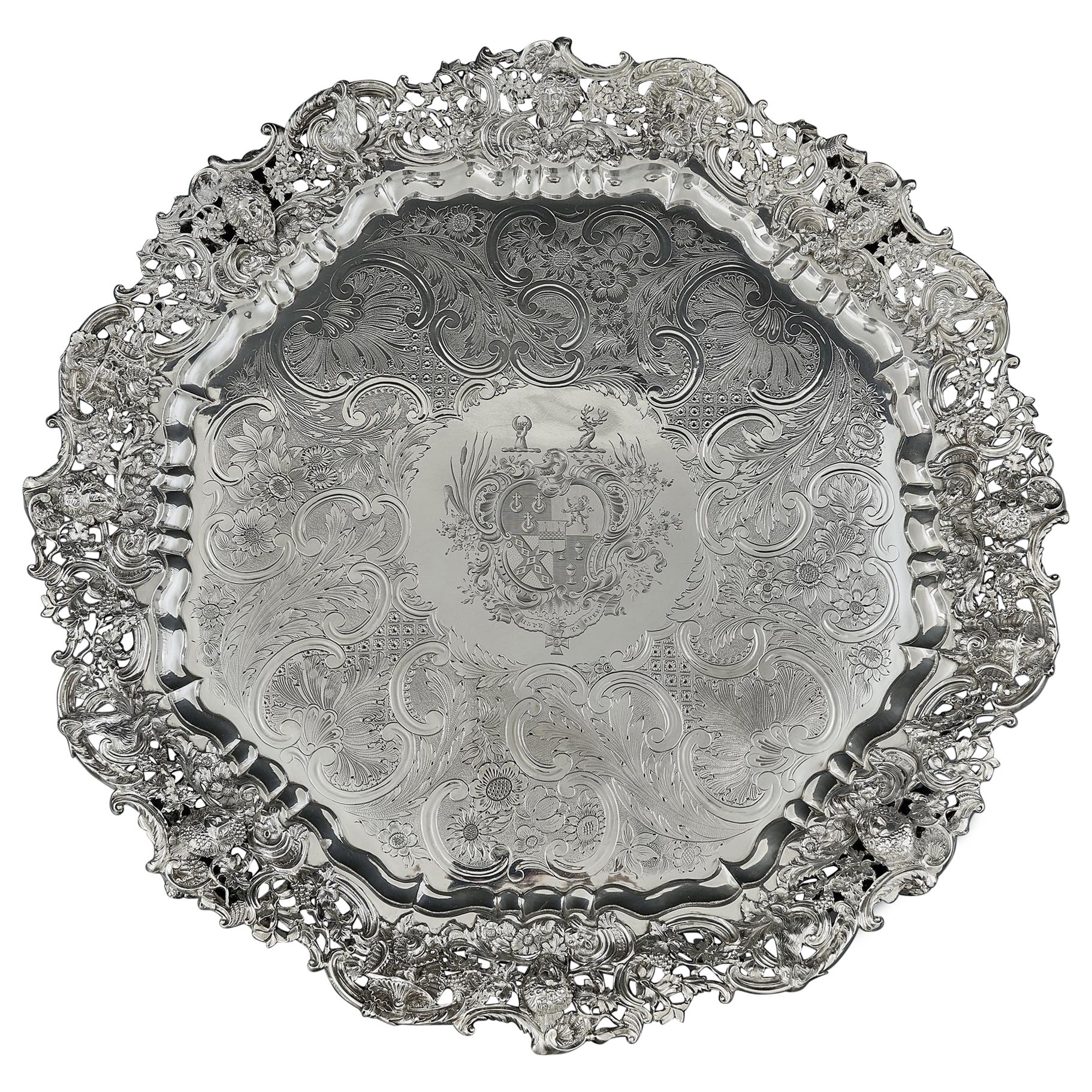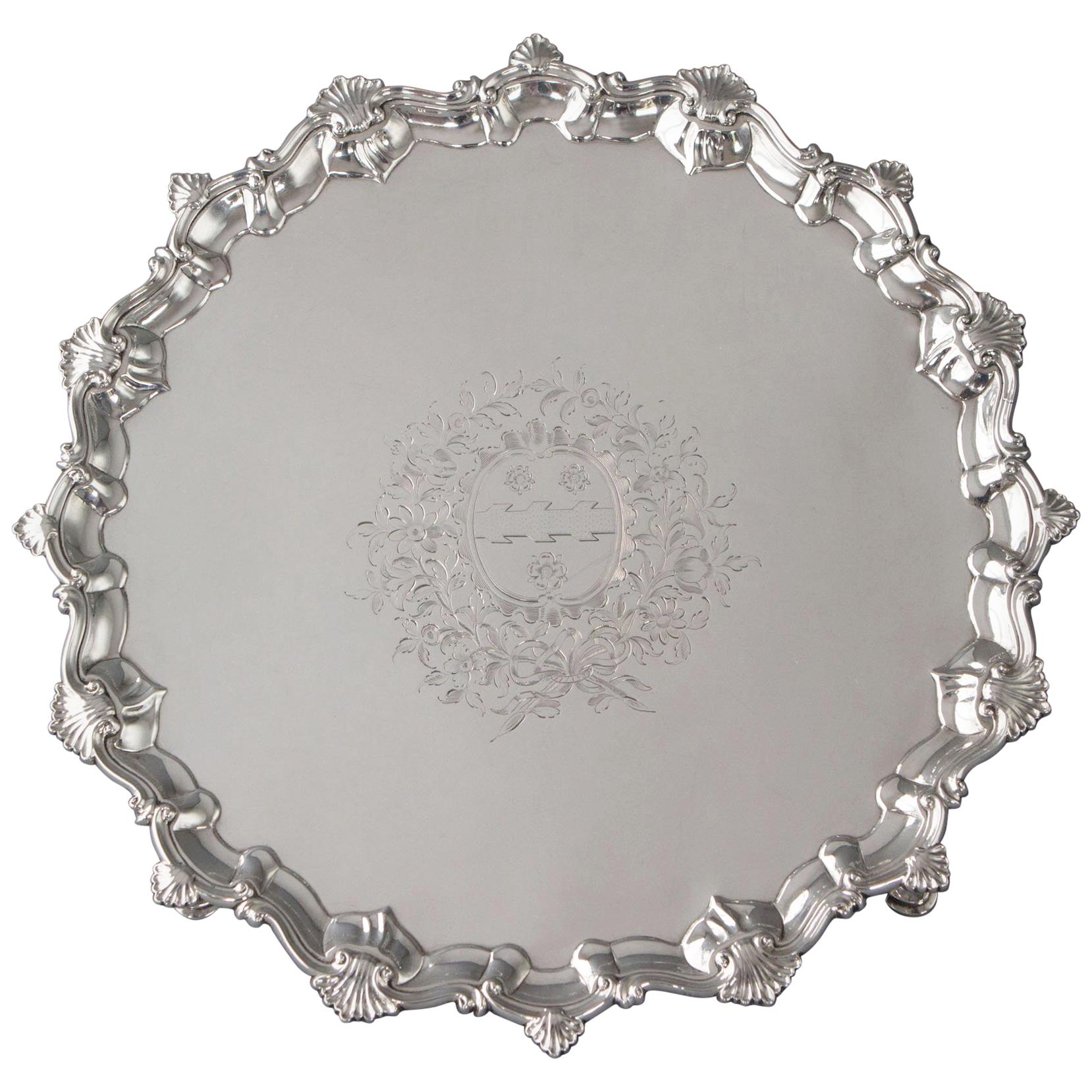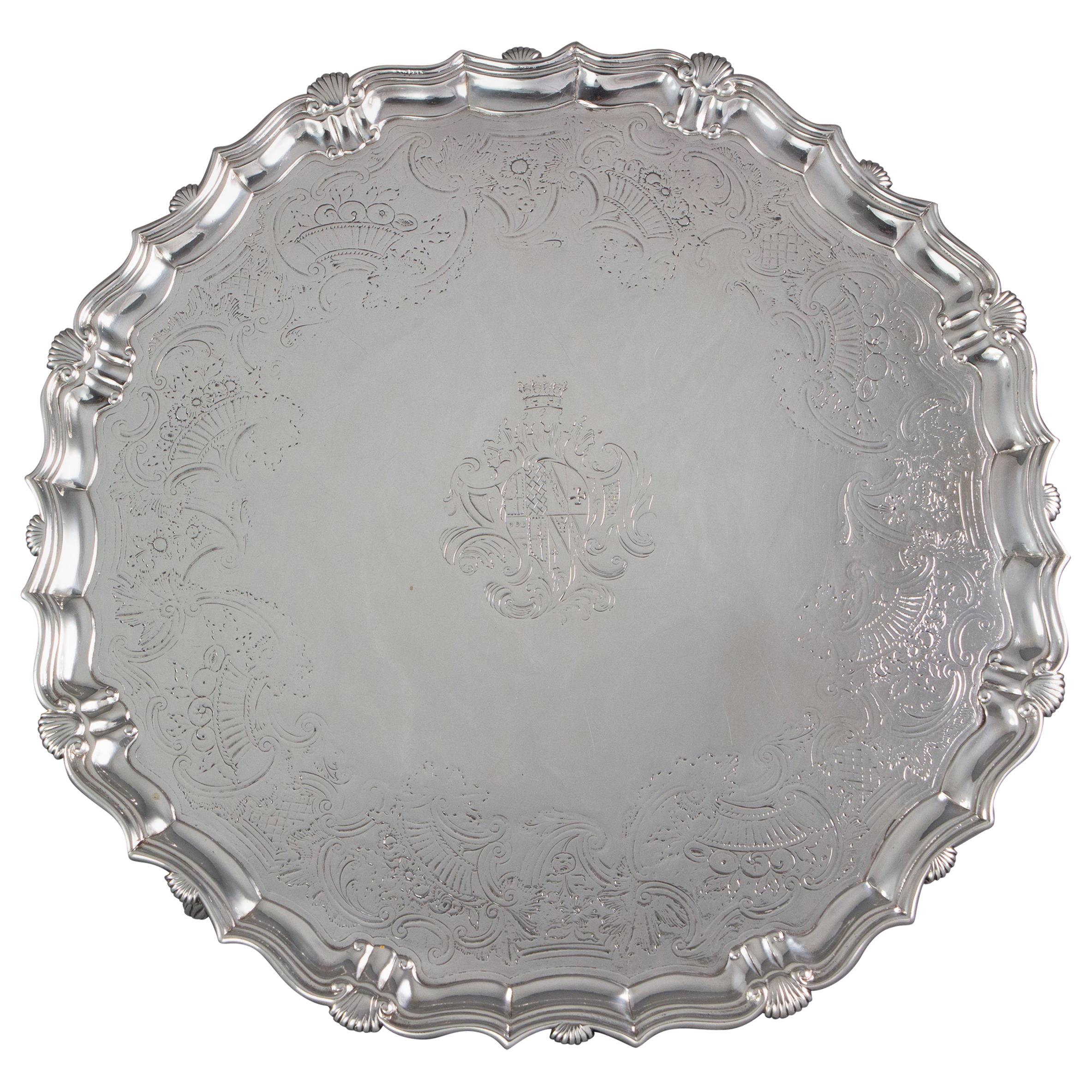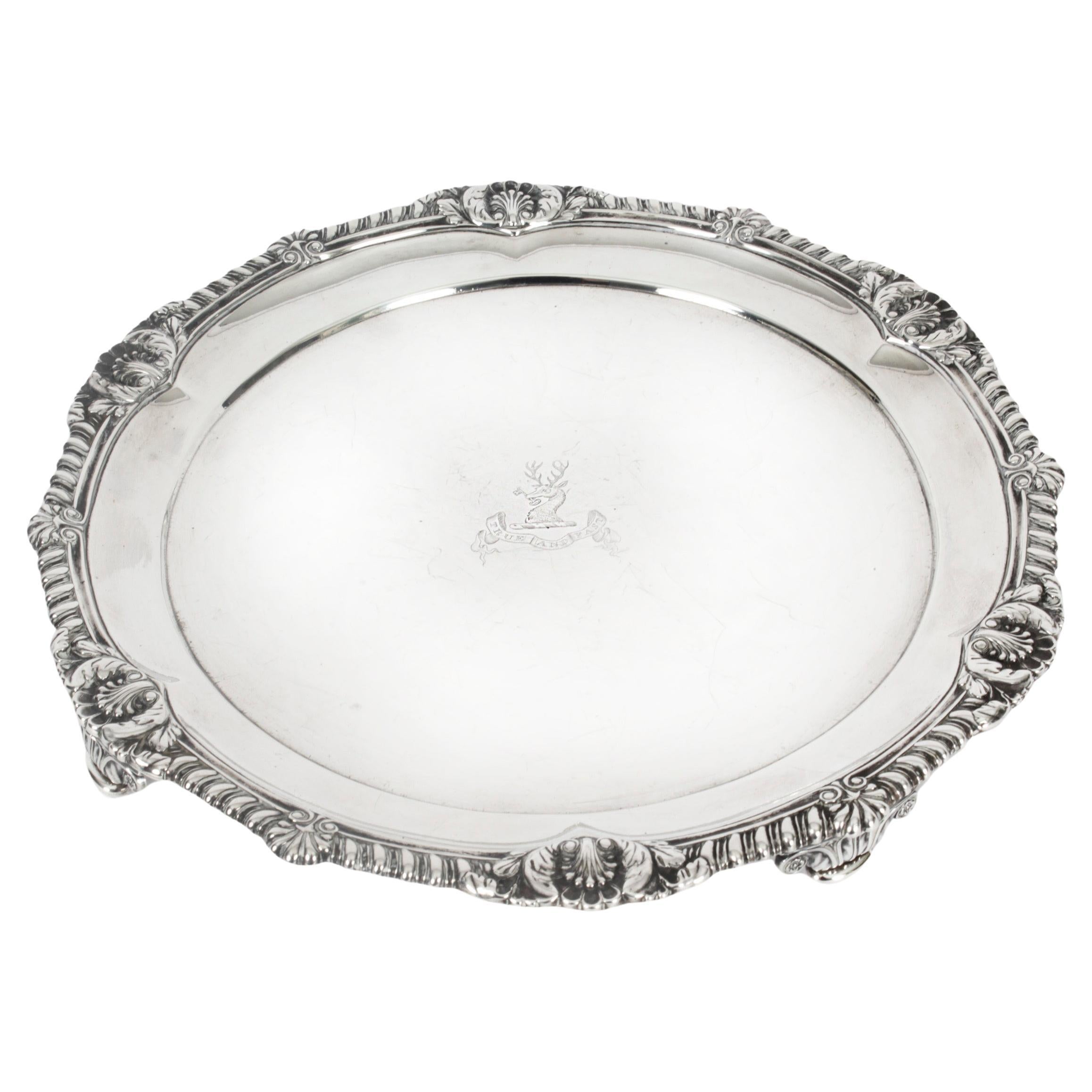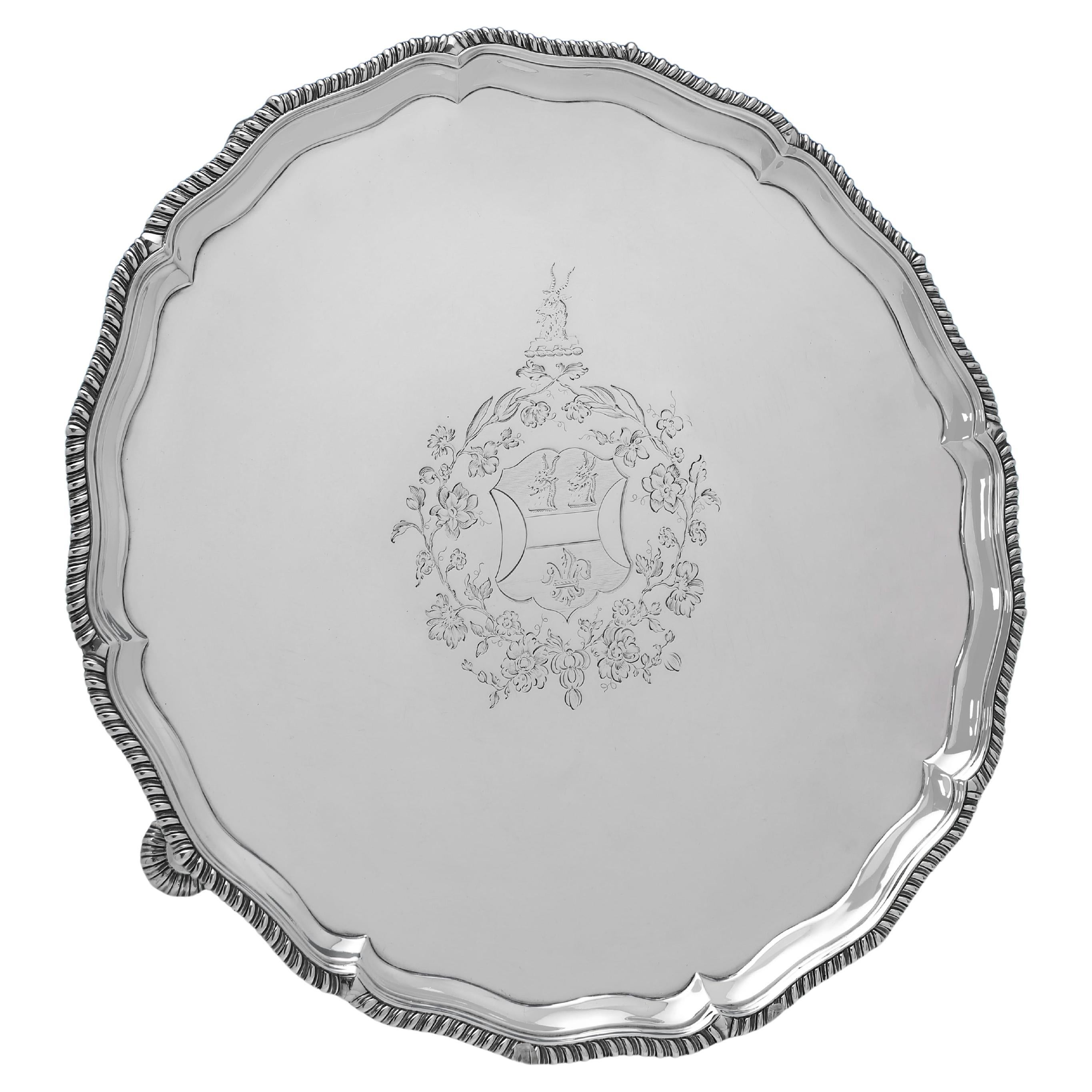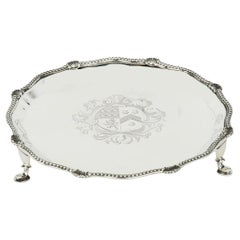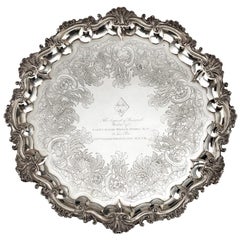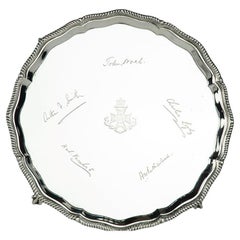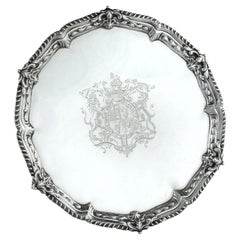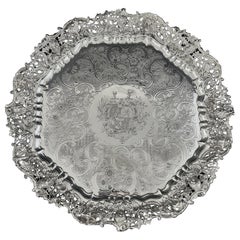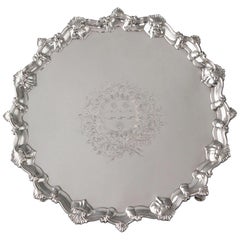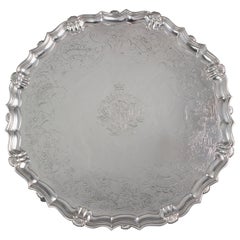Items Similar to A George IV crested silver tray commemorating the marriage Colonel Thomas Arthur
Want more images or videos?
Request additional images or videos from the seller
1 of 5
A George IV crested silver tray commemorating the marriage Colonel Thomas Arthur
$2,780.57
£2,025
€2,370
CA$3,835.99
A$4,216.81
CHF 2,216.16
MX$51,207.45
NOK 27,646.07
SEK 26,192.71
DKK 17,687.89
About the Item
A George IV crested silver tray commemorating the marriage of Lieutenant Colonel Thomas Arthur, 3rd Dragoon Guards, of circular form, raised upon three claw and ball feet with a shell and scroll raised border, the central incised crest and motto within a broad garland of C-scrolls and flowers, hallmarked for Barak Mewburn, London 1827.
Footnote: The crest is a marital one showing the family Arthur impaling Fetherstonhaugh, commemorating the 1845 wedding of Lieutenant Colonel Thomas Arthur and Catherine Mary Fetherstonhaugh. (1804 – 1889) of Kibworth Grange, Kibworth, Leicestershire. The Arthurs were an Irish family from Limerick. A copy of the heraldry report accompanies this item.
- Dimensions:Height: 1 in (2.54 cm)Diameter: 8.5 in (21.59 cm)
- Style:George IV (Of the Period)
- Materials and Techniques:
- Place of Origin:
- Period:
- Date of Manufacture:1827
- Condition:Wear consistent with age and use.
- Seller Location:Lymington, GB
- Reference Number:1stDibs: LU973038279162
About the Seller
5.0
Recognized Seller
These prestigious sellers are industry leaders and represent the highest echelon for item quality and design.
Gold Seller
Premium sellers maintaining a 4.3+ rating and 24-hour response times
Established in 1982
1stDibs seller since 2013
135 sales on 1stDibs
Typical response time: 2 hours
Associations
LAPADA - The Association of Arts & Antiques Dealers
- ShippingRetrieving quote...Shipping from: Lymington, United Kingdom
- Return Policy
Authenticity Guarantee
In the unlikely event there’s an issue with an item’s authenticity, contact us within 1 year for a full refund. DetailsMoney-Back Guarantee
If your item is not as described, is damaged in transit, or does not arrive, contact us within 7 days for a full refund. Details24-Hour Cancellation
You have a 24-hour grace period in which to reconsider your purchase, with no questions asked.Vetted Professional Sellers
Our world-class sellers must adhere to strict standards for service and quality, maintaining the integrity of our listings.Price-Match Guarantee
If you find that a seller listed the same item for a lower price elsewhere, we’ll match it.Trusted Global Delivery
Our best-in-class carrier network provides specialized shipping options worldwide, including custom delivery.More From This Seller
View AllA Victorian silver armorial tray presented to Brig. General Sir Bertram Portal
By Charles Boyton
Located in Lymington, Hampshire
A Victorian silver armorial tray presented to Brig. General Sir Bertram Portal, 17th Lancers, of rounded form with a bracketed, gadrooned rim with eight scallop shells, raised on th...
Category
Antique Late 19th Century English Victorian Tableware
Materials
Silver
Silver salver of a Hero of Trafalgar: Captain Pryce Cumby London, circa 1836
Located in Lymington, Hampshire
A William IV silver salver with shellwork and scroll border, on four feet, profusely chased and engraved with foliate decoration and inscribed in the centre beneath a widow’s coat of...
Category
Antique 1830s English Sterling Silver
Materials
Silver
A George V silver presentation salver for The King’s Royal Rifle Corps
By Goldsmiths & Silversmiths Co. Ltd.
Located in Lymington, Hampshire
A George V silver presentation salver for The King’s Royal Rifle Corps, (60th Regiment of Foot), of circular form with a gadrooned border, raised on four claw and ball feet, the centre with a regimental badge with a Peninsula War...
Category
Early 20th Century English Tableware
Materials
Silver
Presentation silver to the Master Shipwright of Captain Cook’s Endeavour
Located in Lymington, Hampshire
A George III shaped circular silver salver, plain within a shell and scrolling wave border and outer gadrooned edge, engraved with the royal coat of arms, crest and motto (period 1714-1800) of King George III and, on the reverse with a presentation inscription: For the Launching of His Majestys sloop ‘Otter’ 14 Gunns 305 Tonns 26 October 1767 & His Majestys ship ‘Egmont’ 74 Gunns 1643 Tonns 29 August 1768 by Mr Adam Hayes Master Shipwright of his Majestys yard at Deptford; further monogrammed A*H P A*M. Hallmarked for Benjamin Cartwright, London, 1769
Adam Hayes (1710-1785) began his career as ship’s carpenter in Centurion during Commodore Anson’s famous voyage around the world...
Category
Antique 1760s English George III Nautical Objects
Materials
Silver
Valentine Munden’s Prize Money Silver Salver, London, 1792
Located in Lymington, Hampshire
This small oval George III silver salver is raised on four scroll feet with a plain field and curvetto within a triple reed border. The reverse is engraved ‘June 18th 1803 Valentine Munden’s Prize Money when on board the Exeter East Indiaman for the Capture of the French Frigate La Medée.’ Maker’s mark of John Crouch & Thomas Hannam, London 1792.
The naval action took place on the 4th of August 1800 off the coast of Brazil. On that morning, the Royal Navy escort, Belliqueux sighted a squadron of French frigates and, giving chase, captured the largest ship La Concorde whilst the East Indiamen, Exeter and Bombay Castle pursued and took the surrender of La Medée. The Coutts and Neptune were unsuccessful in capturing a third frigate La Franchaise, but the action stands out as the only occasion during the Napoleonic Wars when a merchant vessel captured a French ship of war...
Category
Antique 1790s English Sterling Silver
Materials
Silver
A Victorian Silver Inkstand made in Madras by Peter Orr and Sons in 1880
Located in Lymington, Hampshire
A Victorian Silver Inkstand made in Madras by Peter Orr and Sons in 1880 for Presentation to the 3rd Duke of Buckingham and Chandos, Governor of Madras and Convenor of the “Duke’s Ow...
Category
Antique Late 19th Century English Victorian Inkwells
Materials
Silver
You May Also Like
Large antique George IV sterling silver salver
By Joseph Craddock 1
Located in London, GB
A superb quality antique silver salver or charger in the highly decorative rococo style. Made during the reign of George IV, this large silver salver has a cast openwork border fine...
Category
Antique 19th Century British George IV Platters and Serveware
Materials
Sterling Silver
George II Silver Salver, Richard Rugg, London, 1759
By Richard Rugg
Located in Cornwall, GB
An excellent silver salver with scrolling shell pattern rim and the whole resting on four hoof feet. The center engraved with an armorial. (see pictures) The armorial is surrounded b...
Category
Antique 1750s English George II Platters and Serveware
Materials
Sterling Silver
Large George II Silver Salver London 1738 by John Tuite
By John Tuite
Located in Cornwall, GB
A large and impressive George II octagonal silver salver with pie crust edge and shell decoration. The central plate engraved with cornucopia of fruits and flowers amidst patterned arabesques. The centre engraved with an armorial beneath a crown. The whole standing on four scrolling leaf capped feet.
Marked to the underside for London 1738 by specialist salver maker John Tuite.
This is a large and impressive early Georgian silver...
Category
Antique 1730s English George IV Platters and Serveware
Materials
Sterling Silver
George III Antique Sterling Silver Salver by Hannam & Crouch, London, 1772
By Hannam & Crouch
Located in London, London
Hallmarked in London in 1772 by Hannam & Crouch, this exceptional, George III, antique sterling silver salver, features a shaped gadroon border, an engraved crest to the centre, and ...
Category
Antique 1770s English George III Sterling Silver
Materials
Sterling Silver
Antique George III Sterling Silver Salver by Paul Storr 19th Century
By Paul Storr
Located in London, GB
This is a wonderful English antique George III sterling silver 10 inch salver, by the world famous silversmith Paul Storr.
It has clear hallmarks for London 1811 and the makers mark of Paul Storr.
It is typical of his work with the raised gadrooned rim with anthemion at intervals, on four fabulous foliate bracket feet. The salver is engraved with a crest and motto and the underside is later engraved
Charlotte J. Parke from C. J. Parke, March 1893'
The centre is engraved with a crest above a motto 'True and Fast' and I have researched this crest:
The Crest of Parke
The crest as engraved upon this George III English Sterling Silver Footed Salver by Paul Storr hallmarked London 1811 is that of the family of Parke. It may be blazoned as follows:
Crest: A stag’s head couped sable holding in the mouth a key or
Motto: True and fast
The family of Parke originally hailed from the County of Cumberland in the northeast of England1 later settling in the County of Dorset at Henbury House, Sturminster Marshal, near Wimborne. Given the evidence of the inscription found on the underside of the salver ‘Charlotte J. Parke from C. J. Parke, March 1893’ it was undoubtedly at one time in the possession of Charles Joseph Parke (died 9th March 1893) of Henbury House aforesaid and gifted to Charlotte Josephine Parke (baptised 4th January 1857 died 2nd January 1941) his third daughter by his wife, Ellen Mary Ethelston. I would venture the following hypothesis that the salver was bequeathed to Charlotte in her father’s will that was granted probate at London on the 20th May 1893. The ‘March 1893’ of the inscription acts as a remembrance of the month of the death of her father. It was noted that Charlotte’s father left an estate worth some £66,892, 19 shillings and one pence, a very considerable sum in the last decade of the 19th Century and even thereafter. Charlotte never married and was living at the time of her death at The Coppice, Sixpenny Handley in the County of Dorset. Her will was proved for probate at Llandudno on the 25th March 1941. She left an estate worth £18,866, 10 shillings and 4 pence. Again, a comfortable sum in 1941.
See the photo of Henbury House, Sturminster Marshal, near Wimborne, Co. Dorset. The former seat of the Parke family. The house was destroyed by fire, the remains of which were demolished in the 1990's.
There is no mistaking its unique quality and design, which is sure to make it a treasured piece by any discerning collector.
Condition:
In excellent condition with clear hallmarks and no dings, dents or signs of repair. Please see photos for confirmation.
Dimensions in cm:
Height 2 x Width 26.5 x Depth 26.5
Weight 0.69 kg
Dimensions in inches:
Height 1 inch x Width 10 inches x Depth 10 inches
Weight 1.5 lbs
Paul Storr
born in London England in 1771, was to become one of the most talented silversmiths of the nineteenth century. Today his legacy of exceptionally well crafted silver, found worldwide in museums and private collections, leaves one in awe when compared to that of his contemporaries.After having served a seven year apprenticeship from the age of 14, he began his career in 1792 when he went into a brief partnership with William Frisbee. This did not last and in 1793 a new mark, (his initials ‘P S’) was entered. By the beginning of the nineteenth century he had established himself as one of London’s top silversmiths producing, amongst others, commissions for Royalty.
In 1801 he married Elizabeth Susanna Beyer with whom he was to have ten children. In 1807 Paul Storr entered into a working relationship with Philip Rundell and by 1811 was a partner, and managing the workshops for Rundell, Bridge & Rundell.
During this period he kept his own marks and separate workshop. However it was through Rundell, Bridge & Rundell who were appointed Goldsmith in Ordinary to George III in 1804 that his reputation as a master silversmith grew. His talents lay in being able to transform ideas and designs from Rundell, Bridge & Rundell’s designers, William Theed...
Category
Antique 1810s English George III Sterling Silver
Materials
Sterling Silver
George III period sterling silver salver by Ebeneezer Coker London 1771
By Ebenezer Coker
Located in London, London
Hallmarked in London in 1771 by Ebenezer Coker, this handsome, Antique, George III period, Sterling Silver Salver, stands on 4 flared feet, and features a shaped gadroon border, and ...
Category
Antique 1770s English George III Platters and Serveware
Materials
Sterling Silver
More Ways To Browse
Pewter Charger
Silver Vanity Tray
Vintage Gold Tray
Wallace Silver Plate Trays
Antique Bread Tray
Copeland Spode Platter
Fb Rogers
Georgian Pewter
Majolica Cake
Reed Barton Tray
Silver Butlers Platter
Silver Tray Feet
Staffordshire Blue Platter
Vintage Frying Pans
Vintage Steubenville
Antique Pewter Charger
Bread Tray Silver
Carved Bread Board
